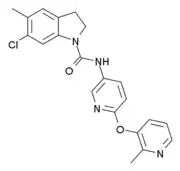SB-242084
SB-242084 is a psychoactive drug and research chemical which acts as a selective antagonist for the 5HT2C receptor.[1] It has anxiolytic effects,[2] and enhances dopamine signalling in the limbic system,[3] as well as having complex effects on the dopamine release produced by cocaine, increasing it in some brain regions[4][5] but reducing it in others.[6][7] It has been shown to increase the effectiveness of the selective serotonin reuptake inhibitor (SSRI) class of antidepressants, and may also reduce their side effects.[8][9] In animal studies, SB-242084 produced stimulant-type activity and reinforcing effects, somewhat similar to but much weaker than cocaine or amphetamines.[10]
 | |
| Identifiers | |
|---|---|
IUPAC name
| |
| CAS Number | |
| PubChem CID | |
| IUPHAR/BPS | |
| ChemSpider | |
| ChEMBL | |
| CompTox Dashboard (EPA) | |
| Chemical and physical data | |
| Formula | C21H19ClN4O2 |
| Molar mass | 394.86 g·mol−1 |
| 3D model (JSmol) | |
SMILES
| |
InChI
| |
References
- Kennett GA, Wood MD, Bright F, Trail B, Riley G, Holland V, et al. (1997). "SB 242084, a selective and brain penetrant 5-HT2C receptor antagonist". Neuropharmacology. 36 (4–5): 609–20. doi:10.1016/S0028-3908(97)00038-5. PMID 9225286.
- Martin JR, Ballard TM, Higgins GA (April 2002). "Influence of the 5-HT2C receptor antagonist, SB-242084, in tests of anxiety". Pharmacology, Biochemistry, and Behavior. 71 (4): 615–25. doi:10.1016/S0091-3057(01)00713-4. PMID 11888553.
- Di Matteo V, Di Giovanni G, Di Mascio M, Esposito E (August 1999). "SB 242084, a selective serotonin2C receptor antagonist, increases dopaminergic transmission in the mesolimbic system". Neuropharmacology. 38 (8): 1195–205. doi:10.1016/S0028-3908(99)00047-7. PMID 10462132.
- Navailles S, De Deurwaerdère P, Porras G, Spampinato U (February 2004). "In vivo evidence that 5-HT2C receptor antagonist but not agonist modulates cocaine-induced dopamine outflow in the rat nucleus accumbens and striatum". Neuropsychopharmacology. 29 (2): 319–26. doi:10.1038/sj.npp.1300329. PMID 14560323.
- Navailles S, Moison D, Ryczko D, Spampinato U (November 2006). "Region-dependent regulation of mesoaccumbens dopamine neurons in vivo by the constitutive activity of central serotonin2C receptors". Journal of Neurochemistry. 99 (4): 1311–9. doi:10.1111/j.1471-4159.2006.04188.x. PMID 17018023.
- Navailles S, Moison D, Cunningham KA, Spampinato U (January 2008). "Differential regulation of the mesoaccumbens dopamine circuit by serotonin2C receptors in the ventral tegmental area and the nucleus accumbens: an in vivo microdialysis study with cocaine". Neuropsychopharmacology. 33 (2): 237–46. doi:10.1038/sj.npp.1301414. PMID 17429406.
- Leggio GM, Cathala A, Moison D, Cunningham KA, Piazza PV, Spampinato U (February 2009). "Serotonin2C receptors in the medial prefrontal cortex facilitate cocaine-induced dopamine release in the rat nucleus accumbens". Neuropharmacology. 56 (2): 507–13. doi:10.1016/j.neuropharm.2008.10.005. PMC 3130963. PMID 18977370.
- Cremers TI, Giorgetti M, Bosker FJ, Hogg S, Arnt J, Mørk A, et al. (October 2004). "Inactivation of 5-HT(2C) receptors potentiates consequences of serotonin reuptake blockade". Neuropsychopharmacology. 29 (10): 1782–9. doi:10.1038/sj.npp.1300474. PMID 15138437.
- Burghardt NS, Bush DE, McEwen BS, LeDoux JE (November 2007). "Acute selective serotonin reuptake inhibitors increase conditioned fear expression: blockade with a 5-HT(2C) receptor antagonist". Biological Psychiatry. 62 (10): 1111–8. doi:10.1016/j.biopsych.2006.11.023. PMC 2129095. PMID 17524369.
- Manvich DF, Kimmel HL, Cooper DA, Howell LL (September 2012). "The serotonin 2C receptor antagonist SB 242084 exhibits abuse-related effects typical of stimulants in squirrel monkeys". The Journal of Pharmacology and Experimental Therapeutics. 342 (3): 761–9. doi:10.1124/jpet.112.195156. PMC 3422522. PMID 22685342.
This article is issued from Wikipedia. The text is licensed under Creative Commons - Attribution - Sharealike. Additional terms may apply for the media files.